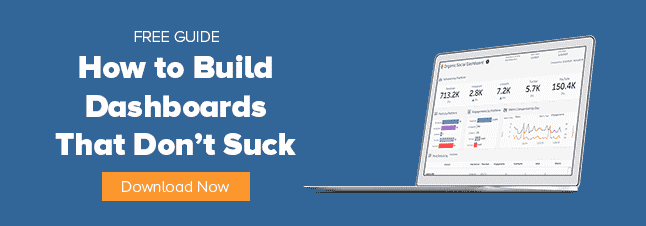
For years, marketers had to rely on gut feelings and intuition about what was going to work in their campaigns. They couldn’t really be sure if a new sale came from an ad they created or if that sale would have happened even if they hadn’t done anything at all.
Fortunately for marketers today — and their sanity — marketing analytics has eliminated the need for that “throwing something at the wall and hoping that it sticks” approach to marketing.
What Is Marketing Analytics?
Great question!
Marketing analytics is the practice of using data to measure, optimize and forecast marketing performance. This allows marketers to …
- Understand the value that marketing is delivering to the business — they know that if they spend $X on advertising, it will usually create $Y in new revenue.
- Use marketing data to drive bottom-line business growth in terms of leads, sales and revenue. Because they know what tactics really work, they can spend more time and money on the winning channels.
Marketing analytics is possible today because of the growth of digital marketing platforms, which provide large amounts of detailed campaign data, and because of marketing analytics software, which allows marketers to quickly collect, store and analyze that data, often using advanced forms of analysis like multi-touch attribution and marketing mix modeling.
Thanks to analytics, marketers don’t have to rely on their intuition anymore. They can use data to guide their strategies and campaigns.
Why Is Marketing Analytics Important?
Analytics can help companies hit the “marketing sweet spot.” You know where to invest your time and money in order to generate the greatest possible return.
Marketing analytics also allows businesses to see how all the parts of their campaign are working together to drive results — and understand which tactics aren’t working. That empowers marketers to optimize their ad spending, directing dollars to high-performing channels and away from low-performers.
With the use of modeling, marketing analytics can even help you forecast the results of future campaigns before you spend a single dollar.
Marketing Reporting vs. Marketing Analytics
Not to be confused with analytics, reporting is simply about measuring your progress and sharing updates on KPIs. It’s the monthly spreadsheet that tells you how many clicks and conversions your latest campaign created, but doesn’t explain why.
Marketing reporting and marketing analytics might seem similar, but there are distinct differences between the two.
- Marketing reporting shows what is happening, and marketing analytics explains why it’s happening.
- Marketing reporting organizes, formats and summarizes while marketing analytics questions, interprets and explores.
- Marketing reporting translates data into digestible information, and marketing analytics recommends the next step.
Think of marketing reporting as the prequel to marketing analytics — the alley-oop to the slam dunk.
Tips for Mastering Marketing Analytics
Whether you’re just getting started with marketing analytics or trying to reach the next level of insight, keep these best practices in mind:
- Start by identifying the questions you want to answer and the metrics that will allow you to do so, then gather the necessary data. When marketers skip this step, they end up including less relevant “vanity metrics” in their reporting and analysis.
- Automate your data aggregation. Most marketers don’t have time for analysis because they’re too busy collecting and organizing their data. There are several platforms, including Alight’s ChannelMix platform, that can help you put an end to manual data prep.
- Start with data that isn’t going to require some mental gymnastics. This is a great tip especially if you are new to the marketing analytics process. Pull data from sources that are easy to manage and comprehend, such as website performance data.
- Ensure the quality and accuracy of your collected data. Make sure that there aren’t any inconsistencies or major outliers in what you have collected.
- Actually use the data you have collected to make future decisions. This may seem obvious, but why do all the legwork of collecting, cleaning and analyzing your data to just not use it? This is going to be what leads you to better ideas and strategies.
- Consistency is key. Even though marketing analytics can seem like this time-consuming, complex task, continuing to make the effort will save you time and increase revenue in the long run.
Resources for Marketing Analytics
Learn more about best practices about marketing analytics and reporting with this collection of posts and eBooks!
- How to Increase Your Insight with the Marketing Analytics Maturity Curve
- 3 Capabilities That Every Marketing Analytics Strategy Must Have
- How to Optimize Marketing Spend
- What Is Data Aggregation?
- What Is a Single Source of Truth?
- What is an API?
- The 6 People Your Marketing Analytics Team Can’t Live Without
- How to Build Marketing Dashboards That Don’t Suck
Take the Next Step on Your Analytics Journey
Want an expert opinion on the best approach for your team’s marketing analytics? Alight Analytics has helped brands and agencies take their marketing analytics process to the next level. Schedule a free consultation with our team today!

